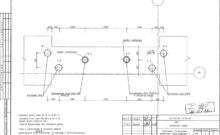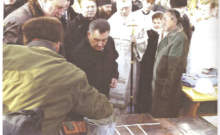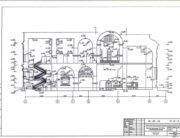Assumption Cathedral was the first stone structure of the Kiev-Pechersk Monastery. Founded in 1073, it was erected during three construction seasons in 1075-1077, the construction was completed from July 1077, and on August 14, 1089 the cathedral was consecrated. The cathedral was a triple six-column single-domed cross-domed temple, brightly decorated inside. The plan of the cathedral had the shape of a rectangle 32.4 x 21.6 meters in length, stretching from east to west, with three semicircular projections (apsides) on the east side. The inner space was divided by three pairs of pillars into three longitudinal and four transverse parts, corresponding to the division of the external walls of the building by pilasters. The pillars were connected to each other and to the walls with the help of spring-loaded arches, on which the vaults and the dome drum rested. The height of the cathedral in the central part reached 43 meters.
According to researcher K. V. Sherotsky, “the lateral apses were at first somewhat lower, and now they have been built up to the height of the middle apse; under the roof sowing. the apse is preserved trail of ancient konhi, above which is also a jagged arch, above the windows of the dome; The apses are now decorated with rich eaves, stucco ornamental friezes and completely covered with patterns … The main apse in ancient times had relief images of the Virgin Mary and the Archangels stand on its sides … at the top the ancient – the middle head and the dome above the Forerunner side the altar “. “In the northwestern chapel, the entire old church of the Forerunner now occupies one altar; there are 4 pillars in it … and three apses … with the choir of the Great Church leads here the ancient door; in the eastern wall in the upper parts of the apses, the entrance to the Transfiguration chapel is pierced; below led stairs here, is now under the floor; windows are visible on the western and southern walls; in the sails there are vocalists, that is, pitchers for better resonance and for lightening the weight of the dome. ”
In the years 1082-1089 the interior of the temple was painted with frescoes and decorated with mosaics, the floor, the handrails were of red slate. In addition to the Greek masters, the painting in the cathedral was also performed by the then young icon painter Alimp. True, in the study of the interior of the Assumption Cathedral in the late XIX century. no trace of frescoes or mosaics was found, it is likely that after the fire of 1718 all the plaster was replaced by a new one. The iconostasis had the appearance of a marble carved partition. Assumption Cathedral became a model by which temples were built in Russia for many years. So, in Kiev, exactly according to this model, the Cathedral of the St. Michael’s Golden-Domed Monastery was built.



















